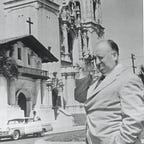Unit 6: A Liturgical Theology of Dwelling
In Richard Kieckhefer’s book, Theology in Stone Church Architecture from Byzantium to Berkeley, one gains an understanding of church architecture and how to examine those church structures with a particular lens that expresses its type. Kieckhefer elaborates these types as the following: classical sacramental, classical evangelical and modern communal churches. Furthermore, Kieckhefer provides four categories to further analyze each type through its spatial dynamics, centering focus, aesthetic impact and symbolic resonance. Personally not being trained in architecture, I appreciated this book in providing the basic knowledge to be able to comprehend church architecture. It allowed me to appreciate the architectural elements of my parish church, Mission Dolores Basilica in San Francisco, California
Misión San Francisco de Asís was founded under the direction of Saint Junipero Serra in 1776 who dedicated that church to Saint Francis of Assisi. The first liturgy was celebrated in August on the feast of Our Lady of Sorrows giving the more popular name to our parish, Mission Dolores. The mission church constructed by the local Ohlone Indians was completed in 1791 and is the oldest intact adobe church structure in California. As San Francisco grew, the parish was then blessed with two church structures: a larger church with the original smaller mission church. The larger church building was a gothic brick structure which collapsed in the 1906 earthquake. Rebuilding happened soon after with the current larger church completed in 1918 , later named a basilica by Pope Pius XII in 1952. According to Kieckhefer, that church structure would be classified as a “classical sacramental church in the basilican plan”(pg. 11). It is a long structure with lower aisles on either side and an apse at the end. As Kieckhefer notes in the section on spatial dynamics, “the very term basilica means royal hall and because the earliest basilicas were built with Constantine’s patronage one might well expect these churches and others to be monuments’’(pg.23).Visitors always comment on the open vast space of the basilica and its “royalness”.
Mission Dolores Basilica is an example of Romanesque architecture. In 1926 the exterior was stylized reflecting a Spanish colonial revival style. The Basilica is a prime example of “California Churrigueresque”, similar to the baroque style found in Spain and Mexico, which became an extremely popular architecture style in California after the 1915 Panama-California Exposition in San Diego. I feel that both the old mission and basilica churches as mentioned by Kieckhefer, “elicit a response even apart from its liturgical use, that the space should give people an experience of the presence of the holy… that is prays itself”(pg.5) People have often shared that they feel that sacredness in both church buildings.
Because of the status of being a basilica, our community has been blessed with Saint Pope John Paul II visiting in September 1987 on his Apostolic visit to the United States. In addition, the parish has hosted various Archdiocesan vespers such as celebrating new installations of the Archbishop or hosting the vigils of deceased bishops. Mission Dolores very much fulfills its “basilica” role.
Furthermore, in analyzing the basilica architecture the arches are lined down the nave directing one’s attention to the corpus and the free standing altar table. As Kieckhefer notes, “the church’s focal point, and acknowledgment that the sacrifice which took place on the cross here becomes sacramentally efficacious, that the altar is the place where sacrifice becomes sacrament.”(pg.69) With the centering focus directly on the corpus, it easily creates a prayerful space. Aesthetically there have been no alterations to the basilica church. Simple in its beauty and interior design, heighted through the large nave and dome, with its amazing acoustics and light shining through the stained glass windows, people experience through all their senses an holistic, spiritual experience. Whether participating in vespers, a liturgical service, choral concert, or organ recital, the basilica church has been able to embody the classical sacramental church characteristic, instilling a “sense of aspiration, of mystery, and of timeliness.”(pg.103). In addition, the basilica has sacred art and symbols, such as the stained glass windows, statues, and the mosaics on side altars and chapels throughout the church.
In conclusion, the minor adjustments I would make to the basilica church would be the following. Replace the orange 1970’s interior perimeter lighting boxes returning back to the electric original candelabra lights. In the nave of the basilica church, I would remove the last four rows of pews on both sides to promote a more hospitable communal feel when entering the basilica. It could be a space where people can gather as a community. My last adjustment in that newly created area would be to add a permanent baptistry. As mentioned by Kieckhefer, “The sacraments require visibility, proximity and accessibility”(pg.55). Placing the baptistry in that new space would remind us visibly as we enter that we are one church in baptism. However, I don’t think this minor change would alter the original aesthetic of this sacred space.
